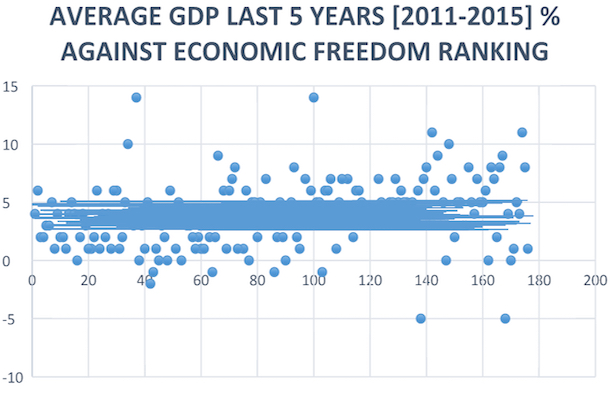
Is Economic Freedom Related to Economic Growth?
Thomas Jefferson observed that “a wise and frugal Government, which shall restrain men from injuring one another, shall leave them otherwise free to regulate their own pursuits of industry and improvement.”
Many economists and sociologists contend that the link between economic freedom and economic growth has been massively over played in the past 35 years. Understanding this issue has important socioeconomic policy implications as economic freedom, as a means of fostering higher economic growth, has been high on the priority list of leading countries like the UK and US. Indeed, virtually every country in the world has embarked on this agenda either voluntarily or at the behest of the World Bank and IMF through Washington Consensus of increasing economic freedom at all costs.
Economic Freedom and Economic Growth
From 1980 to 2008 and during the ‘Great Moderation,’ the world underwent a massive period of economic and financial liberalization that led to greater globalization. That process commenced in the early 1980s in developed countries like the UK and US with Thatcherism and Reaganomics, respectively. Washington Consensus, at the behest of the World Bank and IMF mapped the economic liberalism developed in the West to emerging economies during 1988 to 1991 with disastrous consequences in terms of global economic and financial stability.
The rationale behind economic and financial liberalization has been that it will result in higher economic growth by allowing a greater role for market forces in allocating capital within the global macro-economy. These theories, though now widely criticized emanated from the 1970s work of McKinnon and Shaw.
Liberalization as part of a wider agenda of Neo-Liberalism has become synonymous with the concept of economic freedom. Thus economic freedom has become incorrectly linked to economic growth. Essentially liberalization has pushed state intervention towards decisions made by individuals or ‘rolling back the frontiers of the state’ as Thatcher often said. Liberalization is thus interconnected with the idea of Liberalism. Thatcherism and Reaganomics were taken up by the World Bank and IMF, supported by The Chicago School and specified in reform packages for emerging markets and tied to loan availability and ‘bail out’ conditions.
The Washington Consensus highlighted the following. Deficits should be small and subject to monetary discipline. Education, health and public infrastructure investment are priorities, while subsidies should be eliminated. The tax base should be broad and marginal rates moderate. Interest rates should be market-determined, and positive in real terms. Exchange rates should be at a competitive level (whether fixed or flexible), as an essential element of an outward-oriented trade policy. Import policy should be liberalized and uniform tariffs are preferable if necessary. Foreign direct investment is perceived to be good. Private industry should be managed more efficiently. Deregulation should be the goal of any government. And finally, property rights should be the priority.
The Washington Consensus, a cornerstone of economic freedom was deficient in the sense that it was based upon McKinnon and Shaw’s Financial Liberalization theory which tended to assume perfect information flows in markets as do perfect competition and relied upon institution-free analysis. The higher interest rates that occurred in many emerging economies directly after liberalization helped contribute to the adverse selection and moral hazard problems.
Indeed, the Asian Financial Crisis of 1997 has been blamed on the poor sequencing associated with Washington Consensus and the lack of prudential financial regulation and surveillance that allowed ‘crony capitalism’ to thrive.
In order to test the relationship between economic growth and economic freedom, the following was estimated for 175 countries.
Economic Growth as Measured by GDP Growth % age [average over 5 years] = α + β2 ECONOMIC FREEDOM + ɛ

The slope co-efficient in the chart is only 0.014 [1% significance level, correlation r=0.25%] indicating a very small relationship between economic growth and economic freedom. The data is sourced from the World Bank Economic and Social Indicators Database and the Heritage Foundation Economic Freedom Database. These results corroborate those of Doucouliagos and Ulubasoglu who, using panel data over the period of 1970-1999, find a small relationship between economic freedom and economic growth.
Recommendation
From the analysis in this article, we need to be careful about extrapolating the link between economic freedom and economic growth. Despite this, the World Bank and the IMF have built their agenda on a strong assumed association. Although the analysis is rudimentary yet robust in this research, it appears that no such consideration was undertaken by the IMF and World Bank before the Washington Consensus bulldozed its way around the developing parts of the globe leading to major economic and financial disruption. Arguably this disarray continues today.

